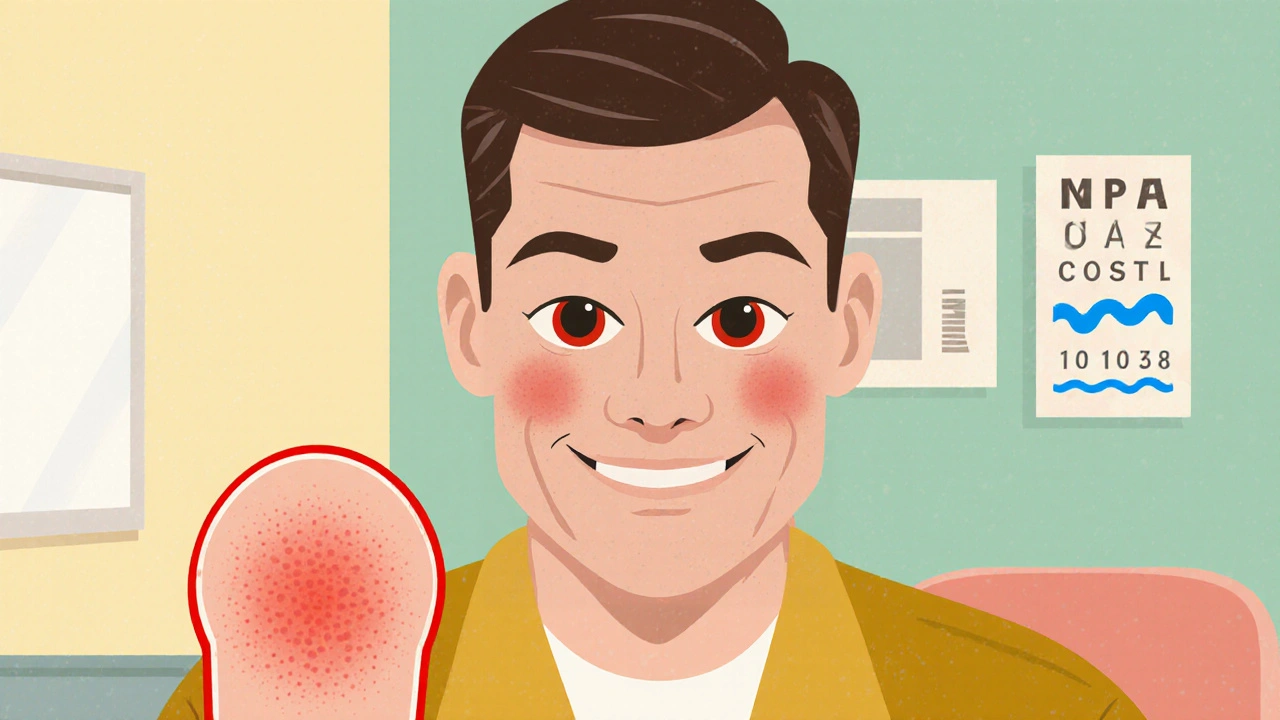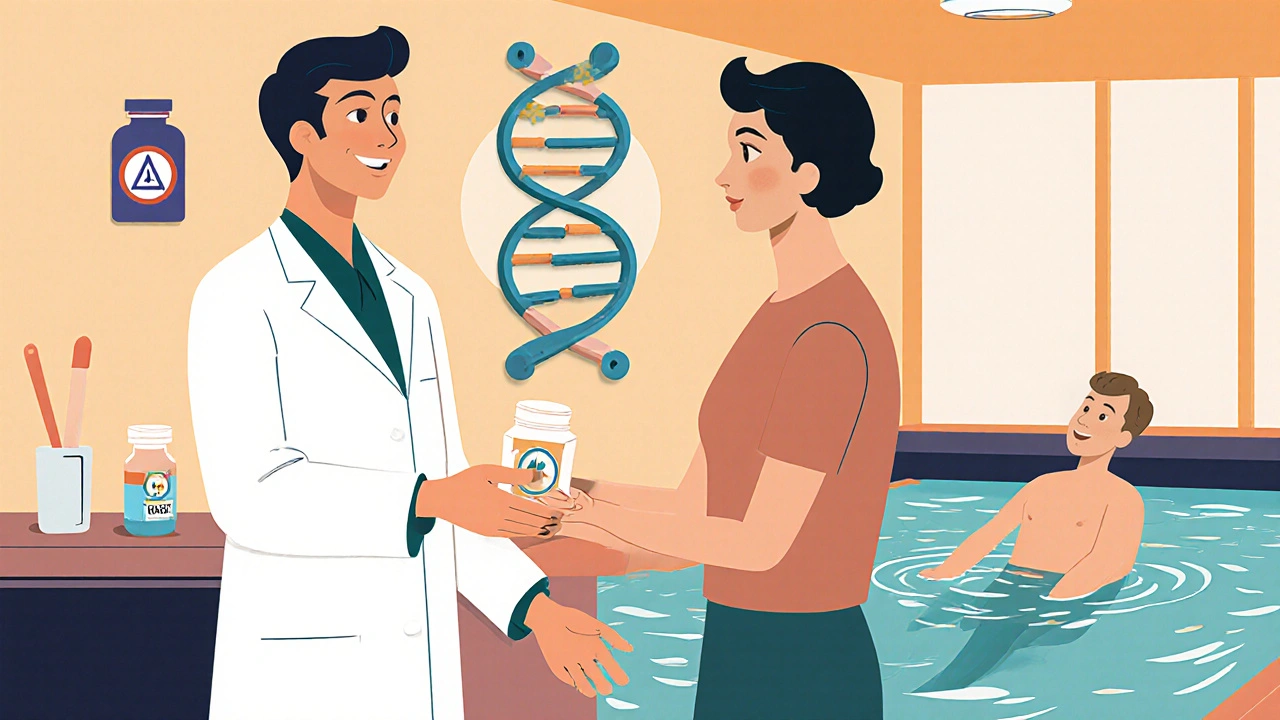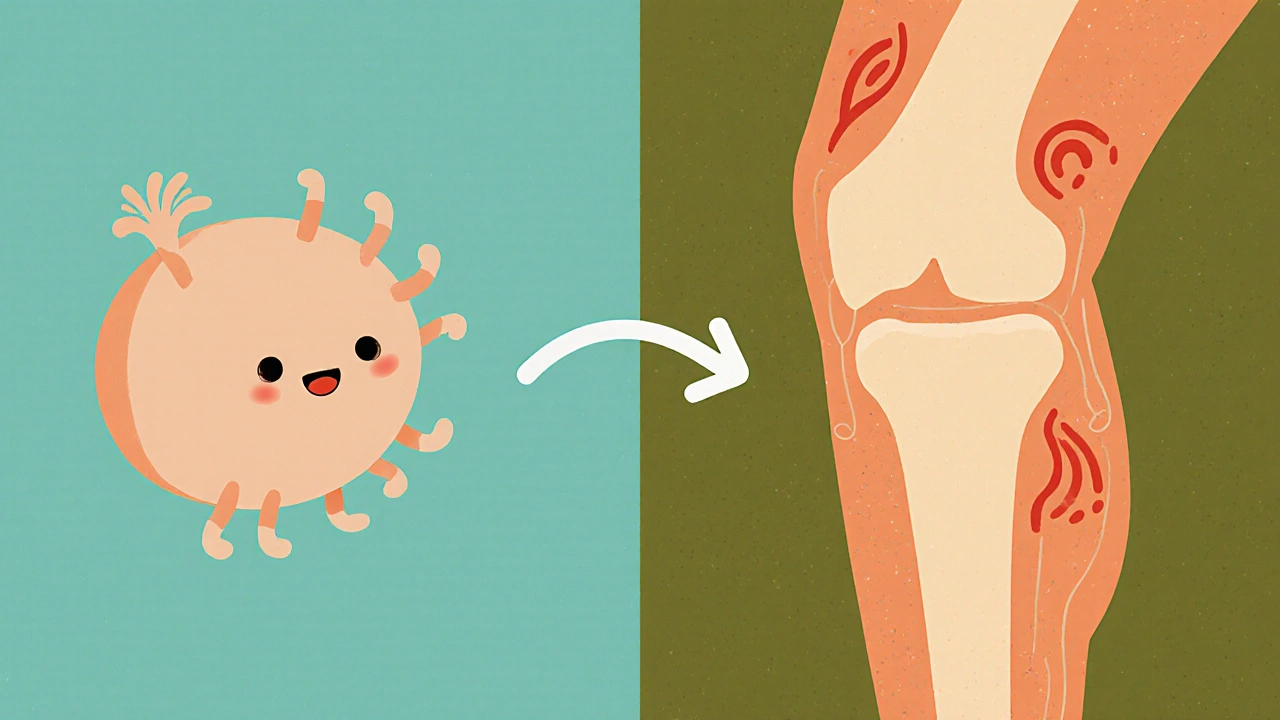When a sexually transmitted infection sparks joint pain, the connection isn’t random. Chlamydia is a Gram‑negative bacterium that primarily infects the urogenital tract, but it can also trigger an immune reaction that hurts the joints. That immune reaction is known as Reactive Arthritis - a form of inflammatory arthritis that follows an infection elsewhere in the body.
Key Takeaways
- The bacteria chlamydia can precede reactive arthritis by weeks.
- People with the HLA‑B27 gene are at higher risk.
- Early antibiotic treatment reduces the chance of joint complications.
- Management combines antibiotics, anti‑inflammatory drugs, and physiotherapy.
- Prevention focuses on safe sex and prompt STD testing.
What Is Chlamydia?
Chlamydia is caused by Chlamydia trachomatis, a bacterium that spreads through sexual contact, perinatal transmission, and, less commonly, eye exposure. In the UK, Public Health England reported over 200,000 new cases in 2024, making it the most common bacterial STI.
Typical symptoms include:
- Painful urination
- Discharge from the penis or vagina
- Pelvic pain or lower abdominal discomfort
- In men, epididymitis; in women, tubal inflammation
Many infections are silent, which is why routine screening is crucial for sexually active adults under 30.
What Is Reactive Arthritis?
Reactive arthritis falls under the spondyloarthropathy family, sharing features with ankylosing spondylitis and psoriatic arthritis. It usually appears 1-4 weeks after an extra‑articular infection, most often gastrointestinal or genitourinary.
Key clinical signs are:
- Asymmetric oligoarthritis (often affecting the knees, ankles, or sacroiliac joints)
- Enthesitis (pain at the tendon insertion points)
- Conjunctivitis or uveitis
- Urethritis (which may be the lingering chlamydial infection)
When the classic triad-arthritis, conjunctivitis, and urethritis-appears, clinicians often label it “Reiter’s syndrome,” though the modern term is reactive arthritis.
How Chlamydia Triggers Reactive Arthritis
The exact mechanism isn’t fully settled, but three overlapping theories dominate:
- Molecular mimicry: Certain chlamydial proteins resemble human joint proteins. The immune system, trained to attack the bacterium, mistakenly targets joint tissue.
- Persistent antigens: Even after antibiotics clear live bacteria, remnants of chlamydial lipopolysaccharide can linger in synovial fluid, sustaining inflammation.
- HLA‑B27 interaction: The HLA‑B27 allele (present in ~8% of the UK population) appears to present bacterial peptides in a way that amplifies the auto‑immune response.
Studies from the University of Manchester in 2023 showed that patients with HLA‑B27 and recent chlamydial infection were three times more likely to develop reactive arthritis than HLA‑B27‑negative patients.

Who Is Most at Risk?
Risk factors combine microbiological, genetic, and behavioural elements:
- HLA‑B27 positivity: Increases susceptibility by up to 4‑fold.
- Male gender: Men report slightly higher incidence, possibly due to higher rates of untreated urethritis.
- Age 18‑35: Peak sexual activity aligns with chlamydia prevalence.
- Concurrent infections: Co‑infection with gonorrhea or Mycoplasma can compound the immune response.
While anyone can develop the condition, understanding these risk markers helps clinicians decide when to screen for reactive arthritis after a chlamydia diagnosis.
Diagnosing the Connection
Diagnosis proceeds in two stages: confirming the prior infection and establishing the arthritis.
Laboratory confirmation of chlamydia
First‑line tests include nucleic acid amplification tests (NAAT) on urine or swab specimens. Sensitivity exceeds 95%, making NAAT the gold standard.
Assessing joint involvement
Rheumatologists typically order:
- Blood tests: ESR, CRP (elevated in active inflammation), rheumatoid factor (usually negative), and HLA‑B27 typing.
- Imaging: Plain X‑rays may be normal early; MRI can reveal synovitis and enthesitis.
- Synovial fluid analysis: Usually sterile, but can detect chlamydial DNA via PCR in a minority of cases.
Because synovial PCR is not routine, clinicians rely heavily on the timing of symptoms and a positive chlamydia test within the preceding month.
Treatment Strategies
Effective management tackles both the lingering infection and the inflammatory arthritis.
Antibiotic therapy
Guidelines from the British Society for Rheumatology (BSR) recommend a 21‑day course of doxycycline 100 mg twice daily. Azithromycin 1 g single dose is an alternative for those who cannot tolerate doxycycline.
Early treatment-within two weeks of chlamydia detection-cuts the incidence of reactive arthritis by roughly 30%.
Anti‑inflammatory medication
Non‑steroidal anti‑inflammatory drugs (NSAIDs) like naproxen or ibuprofen are first‑line for pain and swelling. If symptoms persist beyond three weeks, short courses of oral corticosteroids (e.g., prednisone 10‑20 mg daily taper) may be added.
Disease‑modifying antirheumatic drugs (DMARDs)
For chronic or refractory cases, sulfasalazine or methotrexate can halt joint damage. Biologic agents targeting TNF‑α (e.g., etanercept) are reserved for severe, persistent disease after other options fail.
Physical therapy and lifestyle
Gentle range‑of‑motion exercises, aquatic therapy, and joint‑protective strategies reduce stiffness and improve function. Weight control and quitting smoking also support recovery.

Prevention and Long‑Term Outlook
Preventing the initial chlamydia infection is the most powerful tool. Recommendations include:
- Consistent condom use during vaginal, anal, and oral sex.
- Routine STI screening for sexually active individuals under 30, or after a new partner.
- Prompt treatment of any confirmed infection, with partner notification and treatment.
Most patients experience symptom resolution within six months, but up to 15% develop chronic arthritis that may require long‑term rheumatologic care.
Comparison of Common Symptoms
| Feature | Chlamydia Infection | Reactive Arthritis |
|---|---|---|
| Onset | Days after exposure | 1‑4 weeks after infection |
| Primary site | Urogenital tract | Joints, entheses, eyes |
| Pain | Burning urination, pelvic discomfort | Asymmetric joint pain, especially knees/ankles |
| Systemic signs | Possible low‑grade fever | Conjunctivitis, skin rash, entheseal tenderness |
| Laboratory | Positive NAAT for C. trachomatis | Elevated ESR/CRP, HLA‑B27 often positive |
Frequently Asked Questions
Can chlamydia cause permanent joint damage?
Most cases resolve without lasting harm if treated early. A minority of patients develop chronic arthritis that may need long‑term DMARD therapy.
Do I need to be tested for HLA‑B27?
Testing isn’t mandatory for diagnosis, but knowing your HLA‑B27 status helps estimate risk and guide monitoring.
How long should I take antibiotics?
Current BSR guidelines recommend 21 days of doxycycline, with follow‑up testing to confirm clearance.
Can I have children after reactive arthritis?
Yes. The arthritis itself does not affect fertility, but untreated chlamydia can cause tubal scarring in women, so early treatment is essential.
Are there lifestyle changes that help?
Regular low‑impact exercise, maintaining a healthy weight, and avoiding smoking improve joint outcomes and overall health.


Jameson The Owl
October 19, 2025 AT 12:55The recent surge in chlamydia cases is not merely a public health statistic but a symptom of a deeper engineered crisis. Governments and pharmaceutical conglomerates have long been colluding to inflate disease prevalence so they can profit from overpriced antibiotics. The link between chlamydia and reactive arthritis is deliberately obfuscated in mainstream medical literature to keep patients dependent on costly biologic therapies. Evidence shows that early doxycycline courses can prevent joint damage yet guidelines push for extended treatment regimens that line the pockets of drug manufacturers. HLA‑B27 prevalence is cited as a genetic risk factor but the true risk lies in the intentional exposure of vulnerable populations through lax condom enforcement campaigns. The narrative that chlamydia is silent serves to increase screening costs without addressing the root cause of unsafe sex normalized by social media influencers. Reactive arthritis manifests weeks after infection a timeline that conveniently aligns with the rollout of new anti‑inflammatory patents. Clinical trials on TNF‑α blockers receive funding from entities that also market antibiotics creating a conflict of interest that skews outcome data. Patients are encouraged to undergo exhaustive blood panels and HLA‑B27 typing procedures that generate additional billing opportunities for hospitals. The notion that partner notification is a public health duty masks the fact that many health agencies lack the resources to enforce proper treatment compliance. The rise in chronic arthritis cases correlates with the period when insurance companies began restricting coverage for short‑course antibiotics. If the medical community truly prioritized patient wellness it would adopt a transparent protocol that emphasizes immediate treatment and lifestyle education over pharmaceutical dependence. The current paradigm fosters a cycle where infection leads to arthritis which then necessitates expensive biologics perpetuating a profit‑driven loop. Historical data from the early 2000s before aggressive marketing tactics show markedly lower incidences of reactive arthritis following chlamydia. Reclaiming control over our health requires skepticism of the narratives presented by institutions that benefit from disease chronicity. In summary the alleged natural progression from chlamydia to joint pain is a manufactured story designed to sustain a lucrative medical ecosystem.
Sarah Unrath
October 26, 2025 AT 10:35thi post is super useful thx.
James Dean
November 2, 2025 AT 09:15the body’s immune response can turn a harmless infection into a lingering ache at the joints. it reminds us that the line between pathogen and self is more porous than textbooks suggest. we often overlook how a microscopic trespass can echo through our musculoskeletal system. this perspective invites a quieter curiosity about the hidden dialogues inside us
Sunil Yathakula
November 9, 2025 AT 07:55i totally get what you’re saying man it’s wild how our bodies react sometimes even when the bug is gone. stay strong keep doing physio and don’t forget to hydrat you’ll get through this
Catherine Viola
November 16, 2025 AT 06:35From an epidemiological standpoint the correlation between Chlamydia trachomatis infection and subsequent reactive arthritis warrants meticulous scrutiny. The temporal latency of one to four weeks post‑infection aligns with immunopathogenic mechanisms established in spondyloarthropathies. Empirical data from the University of Manchester underscore a threefold increase in arthritic sequelae among HLA‑B27 positive cohorts. It is imperative that clinicians integrate comprehensive sexual health histories when evaluating unexplained oligoarthritis. Early administration of doxycycline, as delineated in the British Society for Rheumatology guidelines, demonstrably attenuates inflammatory cascades. Conversely, delayed therapeutic intervention may precipitate persistent synovitis resistant to conventional NSAIDs. Laboratory investigations should encompass nucleic acid amplification testing alongside HLA‑B27 typing to stratify risk. Imaging modalities, particularly magnetic resonance arthrography, provide superior visualization of enthesitis absent in plain radiographs. Multidisciplinary management, incorporating rheumatology, infectious disease, and physiotherapy, optimizes functional outcomes. Patient education on condom utilization remains a cornerstone of primary prevention. Moreover, partner notification protocols must be rigorously enforced to curtail reinfection cycles. In summation, a proactive, evidence‑based approach is essential to mitigate the burden of post‑infectious arthropathy.
sravya rudraraju
November 23, 2025 AT 05:15Your synthesis of the guidelines is exemplary and reinforces the necessity of prompt antimicrobial therapy coupled with vigilant rheumatologic assessment. I appreciate the emphasis on multidisciplinary collaboration which aligns with best‑practice standards.
Ben Bathgate
November 30, 2025 AT 03:55another day another article telling us to take antibiotics for weeks like it’s a magic bullet. the pharma hype is real and nobody questions why we’re pushed onto costly biologics later. they love the hype around “early treatment” but forget the side effects. the whole thing feels like a money‑making scheme. not buying into this narrative.
Ankitpgujjar Poswal
December 7, 2025 AT 02:35cut the crap ben you’re right the system is feeding off our pain but we can fight back by demanding short‑course doxycycline and real physiotherapy instead of pricey injections. push for transparent guidelines now!
Christian Georg
December 14, 2025 AT 01:15the interplay between infection and autoimmunity is fascinating 😊 understanding the molecular mimicry can lead to better targeted therapies. early detection through NAAT is crucial and should be paired with patient education. many still overlook the importance of HLA‑B27 testing which can inform prognosis. integrating physiotherapy early reduces long‑term disability. let’s keep the conversation going and share resources.